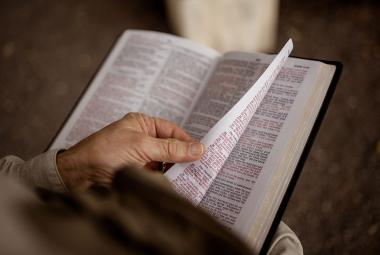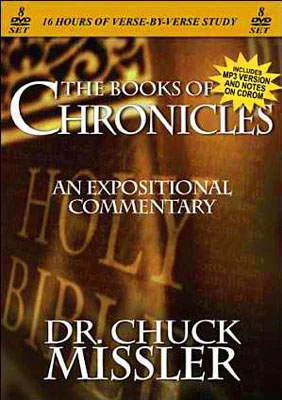In Hebrew, this book is called dibhere ha-yamim: the words concerning the days. The Jewish Bible regards the Old Testament as 22 books and Chronicles is counted as a single book. The Septuagint labels it Paraleipomena, Supplements (to I and II Kings). The Latin Vulgate refers to these books as Chromicon, from which we get our title, Chronicles.
I and II Chronicles take the form of a history: David and Judah are the focal points, with an emphasis on the priestly and Levitical orders. Whereas I and II Kings provide the political record of this time period, I and II Chronicles provide the religious record.
Ezra, Nehemiah, and Chronicles were apparently written together and were added to the Old Testament last. (They were probably compiled by Ezra after the return from the Exile.)
A substantial library was available to the author, including public documents such as letters to and from Cyrus, Artaxerxes, Darius, and Artaxerxes Longimanus (Ezra 1:1; 6:3; 4:7,17; 5:6; 6:6; 7:11; Neh 2:7).
Overview
I Chronicles parallels II Samuel very closely, and II Chronicles parallels the Kings. The emphasis of I and II Chronicles is on the Southern kingdom and the preservation of the Davidic line.
The first nine chapters in I Chronicles are a genealogy from Adam to Jacob, Jacob to David, and David to Zedekiah. The writer of Chronicles, who is concerned with the nation and the monarchy, starts with Adam. The Holy Spirit is pointing out, in effect, that all mankind benefits, not just the Jews. The last 20 chapters cover David's reign in Jerusalem.
The Davidic Covenant
And now, LORD, thou art God, and hast promised this goodness unto thy servant: Now therefore let it please thee to bless the house of thy servant, that it may be before thee for ever: for thou blessest, O LORD, and it shall be blessed for ever.
1 Chronicles 17:26-27
The house to be built for David would be a royal house and a dynasty of kings. It would originate with him but would never end (2 Sam 7:16). The kingdom and its throne would be permanent; a realm over which the Son of David would reign forever (2 Sam 23:5).
The promise that David and his seed would be kings fulfilled the even more ancient Abrahamic Covenant blessing that the patriarchs would be the fathers of kings (Gen 17:6, 16; 35:11). To Judah, the great-grandson of Abraham, was given the explicit pledge that a promised ruler would come from him (Gen 49:10). Samuel anointed David himself from Judah, of whom the Lord said, He is the one (1 Sam 16:12). David was aware of his election by God and of the theological significance of that election as part of the Messianic line that would result in a divine Descendant and King (Ps 2:6-7; 110; cf. Ethan's words, Ps 89:3-4).
The prophets also attested to the Davidic Messiah, the One who would rule over all and forever on His throne (Isa 9:1-7; 11:1-5; Jer 30:4-11; Ezek 34:23-24; 37:24-25; Amos 9:11-15). The promise that the people of the Lord, David's kingdom Israel, would have an enduring land of their own was also based on earlier commitments of the Lord: The seed of Abraham, God said, would be given Canaan as a home forever (Gen 13:15; 15:18; 17:8; Deut 34:4). This very commitment is being challenged by the world today.
Solomon's Temple
The second book of Chronicles includes Solomon's 40-year reign and Judah's history until the Exile, focusing on the Southern kingdom only-the division of the kingdom, the 20 kings of Judah, and their deportation to Babylon.
The Temple represents the zenith of Israel's glory and is a major topic in both the books of Kings and Chronicles. The design of the Temple, even though Solomon built it, was given by God to David.
To build the Temple, Solomon pulled together a 183,000-person work force: 30,000 men who worked 10,000 at a time for a month and were off for two months to go home; 70,000 carriers; 80,000 hewers in the mountains; and, about 3,300 supervisors.
The basic design of the Temple was like the Tabernacle except that it was twice as big-every dimension was doubled. Instead of a single menorah, there were 10 lampstands. Instead of one table of showbread, there were 12. And there were some things added. First of all, in front of a region well call the porch, there were two gigantic bronze pillars with names: Jachin (in his counsel) and Boaz (in his strength). There were storerooms for the personal effects of the priests, but they were also where the priests hid their personal idols. All these features turn out to be spiritually relevant.
What is the significance of the porch and the Inner and Outer Courts? The New Testament says, You are the Temple of God seven times. There is something complete about seven.
My wife spent 20 years researching the question: What do we mean by the heart, soul, spirit, and mind? The Great Commandment says we should love the Lord with all our heart, soul, and strength. When Jesus quotes that he adds mind. What do these words mean? What is the difference between the heart and soul and spirit? Hebrews 4:12 says that only the Word of God can discern between the soul and the spirit.
The Temple architecture is the key to understanding the architecture of our software (behavior). You cant learn about someone's behavior from x-rays or MRIs or CAT scans. Its software, not hardware. How do you determine the architecture of the software?
Though we looked at the Tabernacle being body, soul and spirit, the Temple refines it: the Outer Court seems to be relative to the body; the Inner Court, the soul; we have the heart in the Holy Place; the spirit in the Holy of Holies; and, the porch is the transition or choice point. Everything outside the porch is bronze (the metal that can sustain fire). Everything inside the porch is gold.
The point is that we determine our lives by the decisions we make through our will power-through our volition, if you will-at the porch area.
The Holy Spirit dwells within us, but why don't we see Him more in our lives? Because we throttle Him, in effect, at the porch. Part of our walk is to take every thought captive, to make faith choices, not soul- or body-driven decisions. This is the research that underlies my wife Nancy's trilogy series: The Way of Agape, Be Ye Transformed, and Faith in the Night Seasons.
What, then, is the role of the storehouses? One suggestion is that they may relate to our subconscious mind. Around that lies a lot of fruitful study.
Solomon was very brilliant-even before he asked for wisdom-but he lacked moral vigor. He was very bright, but he wasn't decisive. He also became excessively self-indulgent. He presided over the peak of Israel's prosperity. The Queen of Sheba couldn't believe the stories she heard about Solomon, so she actually traveled to meet with him. She's famous for saying, The half of it was not told me. The splendor of the kingdom under Solomon was staggering, even by todays standards.
Yet, Solomon, in all of his glory, is always an adverse reference point in the Scripture. Jesus said of the lilies, Solomon, in all of his glory, was not arrayed as one of these. In other words, he's used as a very high point but not quite high enough. May that be an example for us all.







